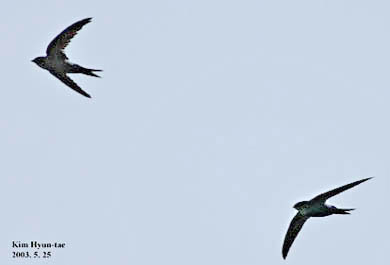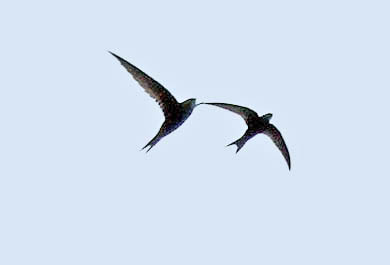how much longer before it's added to the Korean list?
Although the Common Swift Apus apus breeds across much of Europe and Asia, east as far as northern China's Hebei Province (being locally numerous in Beijing for example), there are very surprisingly as yet no confirmed records of the species in either neighboring Deomcratic People's Republic of Korea/North Korea (not being listed in Tomek, 1999) or in South Korea (not being listed in Lee, Koo and Park [2000], or in subsequent unofficial checklists).


This is especially surprising considering both the increased reporting of extralimital species such as Himalayan Swiftlet Collocalia brevirostris and House Swift Apus affinis in South Korea, and also the proven vagrancy of the region's Pacific Swift Apus pacificus on several occasions to Europe! The lack of confirmed records, however, belies its likely status here. There have already been several recent observations of suspected Common Swift in South Korea - mostly in late autumn along the south coast, with for example the first noted on Gageo Island on October 1st, 2001 (NM); a second in Busan on November 12th, 2002 (NM); and 3 together also on Gageo Island, on October 7th, 2003 (Mathias Ritschard et al, in lit.). They were identified as putative Common Swift simply on the basis of appearing all-dark above during prolonged views, but as they were all viewed at moderate distance, separation from the obvious confusion species Pacific Swift (otherwise known, rather confusingly as Northern White-rumped or Fork-tailed Swift) could not be confirmed - not to the level necessary for claiming a national first record.
The Pacific Swift is the only regular and locally common swift species on the Korean peninsula, summering primarily on offshore islands in both the Yellow Sea and the East Sea/Sea of Japan, and much less regularly inland (nesting inland in Northeastern DPRK, for example). As a migrant, records span February through until October (occasionally inland, but largely coastally) with the majority passing through in August and early September (with one peak count of 690 south through Busan, on September 14th, 2003 [pers obs]). Most of these migrant and nesting Pacific Swift stay high-up, or fly and feed along cliffs of coastal stacks and islets, rarely offering good, close views. On many occasions, the white rump-band can therefore appear obscured or even absent, until birds move significantly closer. Structurally too, both Pacific and Common Swift can appear confusingly similar (despite the former being said to be “more fork-tailed”) - even when viewed in direct comparison (as at Beidaihe in May 1992, when mixed flocks of both species were seen on several occasions: pers obs).
Considering the difficulties of confident identification of birds all too often seen only briefly and in silhouette, it seems likely that South Korea's first acceptable record of Common Swift will need to be based on prolonged, close views either at a favored hilltop watch point, or more likely on a remote offshore island, where plumage details can be comprehensively described, and perhaps even photographed.
Might this be one of South Korea's "2004 new birds" - as a spring overshoot on Socheong, or in line with recent claims, in late autumn on Hong Island, one of 2003's leading rarity hotspots?
References:
- Lee, W-S, Koo, T-H & J-Y Park, 2000. A Field Guide To The Birds of Korea. LG Evergreen Foundation.
- Tomek, T. 1999. The birds of North Korea. Non-passeriformes. Acta zool. Cracov. 42 (1): 1-217.

This short note came about in response to a request from Ulrich Tigges, editor of the virtual magazine "APUSlife", for information on the status of Common Swift in Korea.
To view APUSlife go to www.swift.utigges.il.eu.org



